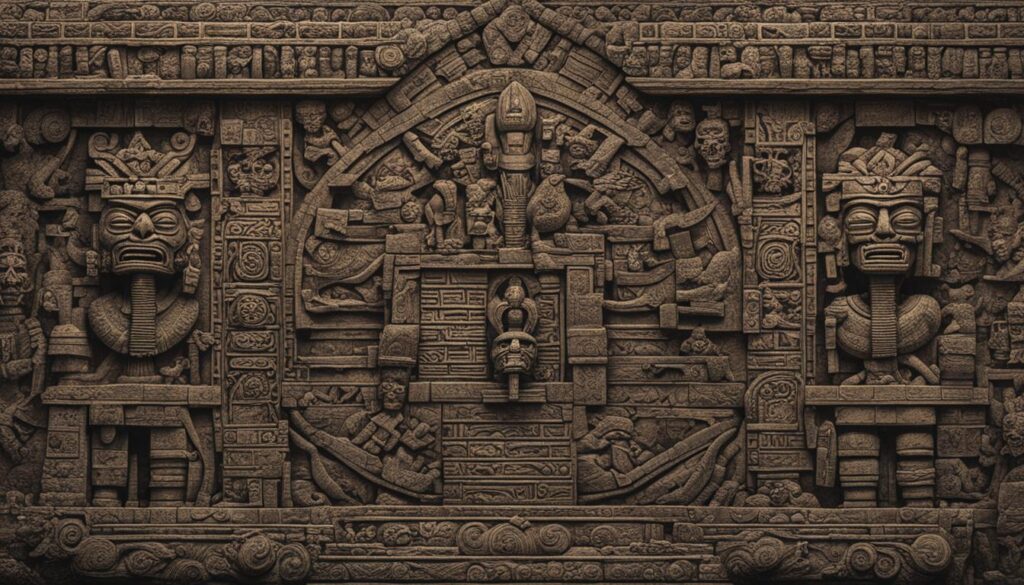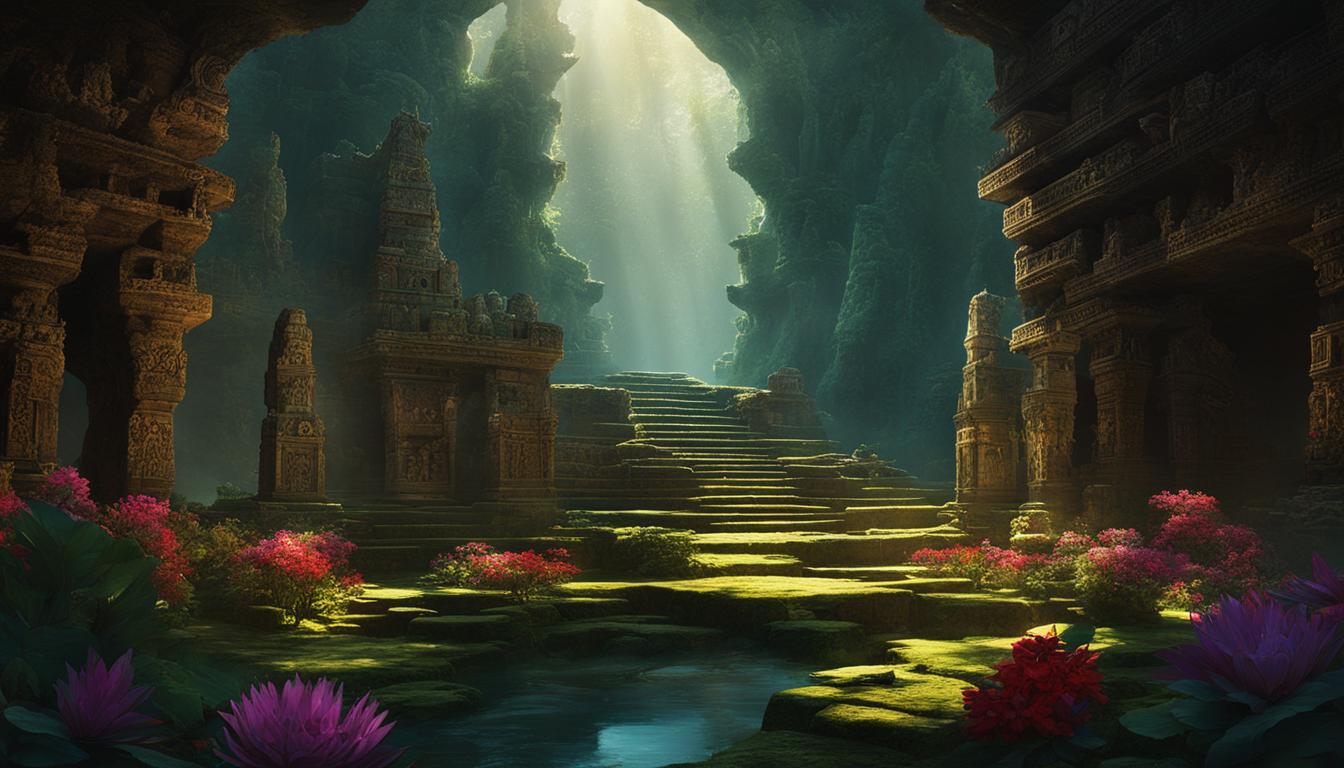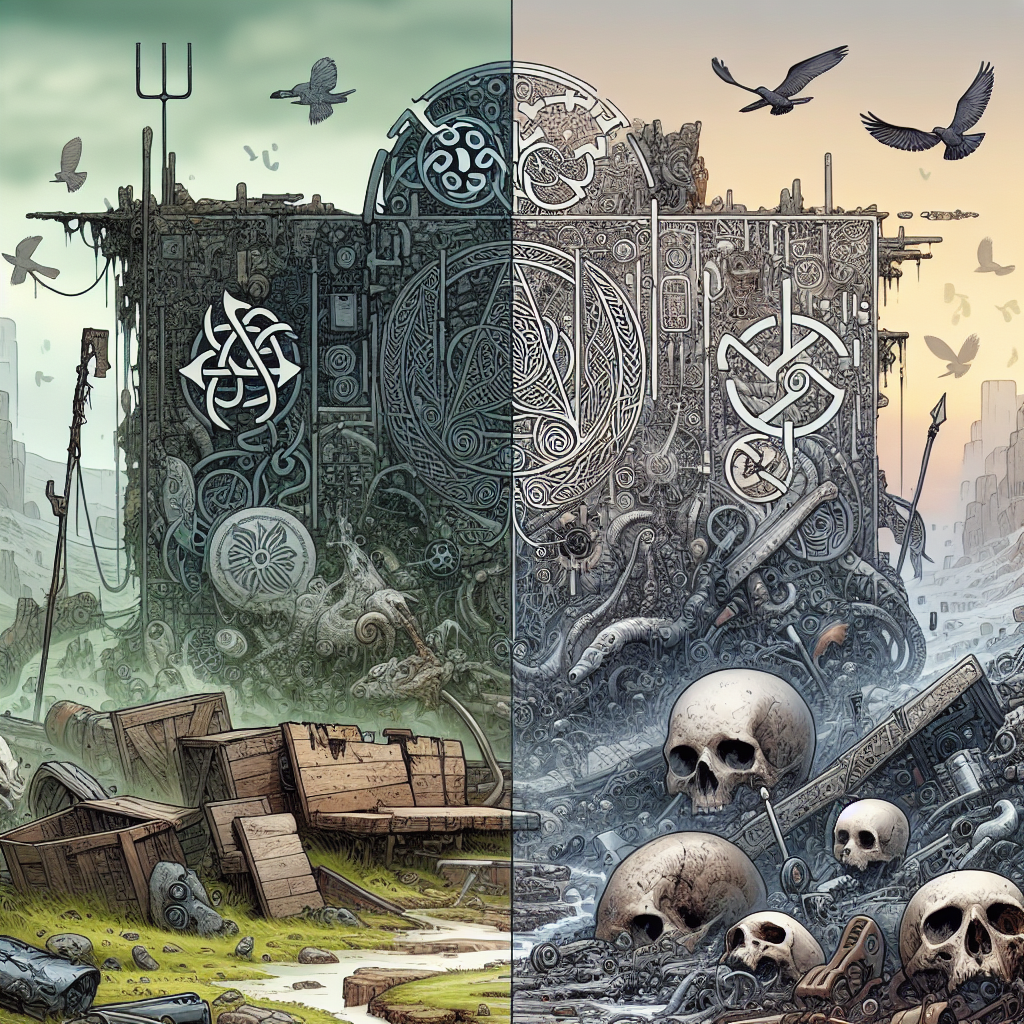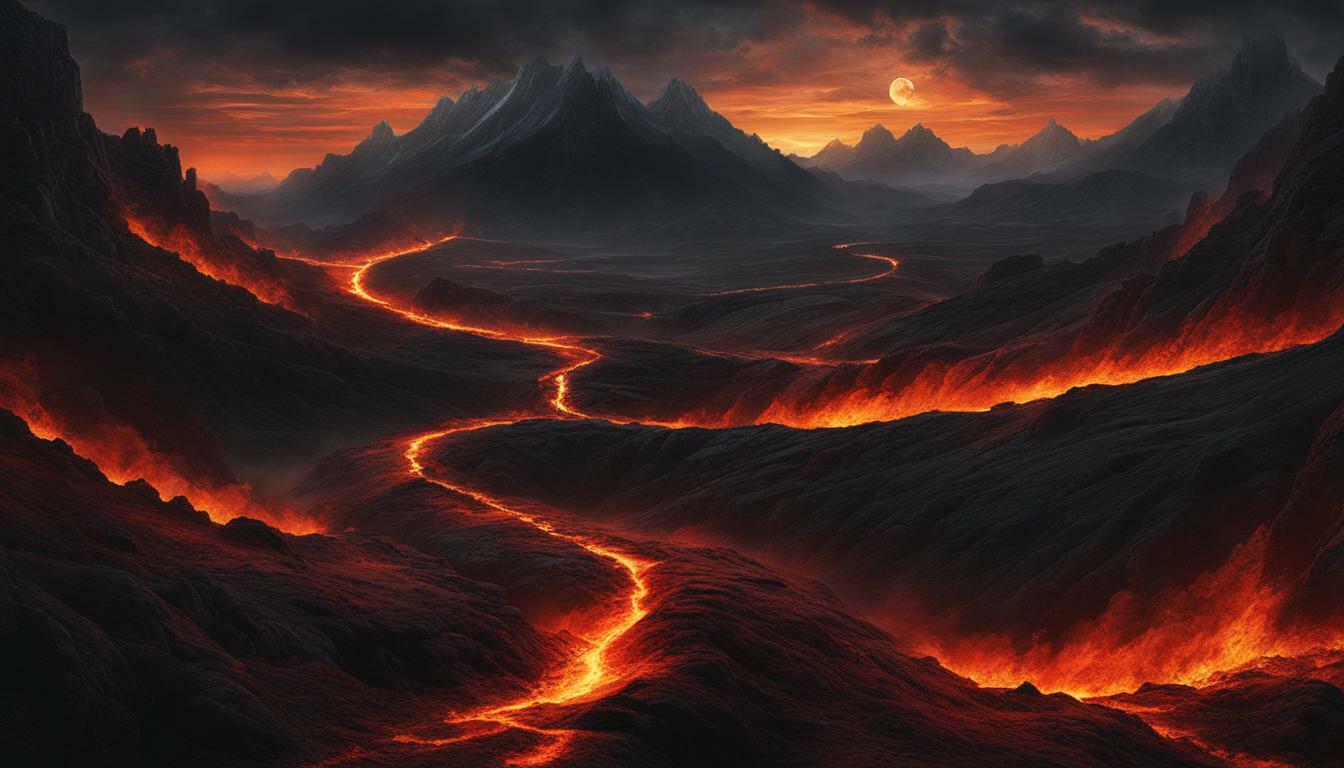In Aztec and Maya mythology, the underworld played a significant role. Both the Mayan Xibalba and the Aztec Mictlan symbolized realms where violations of religious and moral rules were punished. Let’s explore the differences between these two intriguing underworlds.
Key Takeaways:
- The Mayan Xibalba and the Aztec Mictlan were both representations of the afterlife in their respective mythologies.
- Mayan Xibalba was a nine-leveled underground place of fear, ruled by the Lords of Death.
- Aztec Mictlan was a wide and dark place without windows, described as a treacherous journey through nine hazards and dangers.
- Punishments in both underworlds included physical torture and the agony of being cut off from God.
- The beliefs about the afterlife in Mayan and Aztec cultures were complex and influenced by their unique mythologies.
Mayan Xibalba
The Mayan civilization had a rich mythology that included a complex belief in the afterlife. At the heart of their beliefs was Xibalba, the Mayan underworld. Xibalba was often depicted as a nine-leveled underground place of fear and darkness, ruled by the Lords of Death. It symbolized a realm where violations of religious and moral rules were punished.
The journey to Xibalba was perilous and involved facing dangerous challenges. The deceased had to navigate treacherous paths filled with snakes and encounter demons that fed on human hearts. This harrowing journey was accompanied by Xolotl, a dog associated with the deity. Only after passing all the challenges could the deceased approach the Lords of Death in Xibalba.
Xibalba represented the Mayan concept of the afterlife, where transgressions in the mortal world were met with punishment, and the journey to the Land of the Dead was a test of strength and courage.
Table: Comparison of Mayan Xibalba and Aztec Mictlan
| Xibalba | Mictlan |
|---|---|
| Ruled by Lords of Death | Ruled by Mictlantecutli and Mictecacihuatl |
| Nine-leveled underground place of fear | Wide and dark place without windows |
| Challenges include crossing paths with snakes and encountering demons | Challenges include crossing a path with sharp winds and a river of blood |
| Depicted as a place of punishment for violations of religious and moral rules | Also presented as a place of punishment for transgressions |
Aztec Mictlan
In Aztec mythology, Mictlan was the underworld where the deceased journeyed after death. It was described as a vast and dark place without windows, often referred to by different names such as Ximoayan and Atlecalocan. According to ancient beliefs, reaching Mictlan involved a treacherous journey through nine hazards and dangers, symbolizing the return to the maternal womb. The journey took four years to complete, and during this time, the dead faced various challenges such as crossing a path with sharp winds and navigating a river of blood inhabited by fearsome jaguars.
To accompany the deceased on this journey, they were accompanied by Xolotl, a dog associated with the deity. Xolotl guided the souls through the obstacles and ensured their safe passage to Mictlan. Finally, after four years, the deceased reached Mictlan, where they could approach Mictlantecutli and Mictecacihuatl, the Lord and Lady of death who ruled over the Land of the Dead.
Punishments in Mictlan
Within the Aztec Mictlan, violations of religious and moral rules were met with various punishments. The deceased encountered physical tortures such as fire, walking upside down, eating excrement, and drinking urine. These punishments served as deterrents, emphasizing the importance of adhering to religious and moral codes during life. Additionally, the dead in Mictlan experienced the agony of being cut off from God, further magnifying their punishment.
The specific details of the punishments varied within Aztec mythology, but the overall theme remained the same – a harsh and unforgiving afterlife for those who transgressed. These punishments were meant to maintain order and uphold the moral fabric of Aztec society.
Aztec Mictlan Table
| Punishments in Mictlan | Explanation |
|---|---|
| Physical tortures | Fire, walking upside down, eating excrement, drinking urine |
| Being cut off from God | An agonizing separation from divine presence |
Punishments in the Underworlds
In both the Mayan Xibalba and Aztec Mictlan, violations of religious and moral rules were met with harsh punishments. These punishments served as deterrents to ensure adherence to the codes of conduct in the living world. The specific details of the punishments varied in each mythology, but they shared the overarching theme of a harsh and unforgiving afterlife for those who transgressed.
In the Mayan underworld, Xibalba, the punishments were gruesome and involved physical torture. The dead were subjected to fires, forced to walk upside down, eat excrement, and drink urine. They also suffered the agony of being cut off from God, adding to their torment.
In the Aztec underworld, Mictlan, the punishments were equally brutal. The dead faced physical torments such as walking through paths with sharp winds, crossing a river of blood infested with jaguars, and encountering terrifying demons. They too experienced the anguish of being separated from God.
The severity of these punishments reflected the significance placed on religious and moral values in both Mayan and Aztec cultures. They served as a reminder to the living of the consequences of transgressions and the importance of following the prescribed codes of conduct.

Punishments in the Mayan Underworld: Xibalba
| Punishments | Description |
|---|---|
| Fire | Deceased were subjected to burning flames as a form of torment. |
| Walking upside down | The dead were forced to walk in an inverted position, adding to their suffering. |
| Eating excrement | The deceased were compelled to consume feces, a revolting punishment. |
| Drinking urine | The dead were made to drink urine, further degrading their existence. |
Punishments in the Aztec Underworld: Mictlan
| Punishments | Description |
|---|---|
| Path with sharp winds | The deceased had to traverse a treacherous path with strong and cutting winds. |
| River of blood with jaguars | The dead had to cross a river of blood infested with fearsome jaguars. |
| Terrifying demons | Encountering terrifying demons added to the torment of the deceased. |
Beliefs about the Afterlife
In both Mayan and Aztec cultures, beliefs about the afterlife held significant importance. These ancient civilizations had complex and intricate notions of what awaited individuals after death, shaped by their respective mythologies and cultural practices.
The Mayans believed that the fate of the deceased in the afterlife was closely tied to how they died. Those who died violently or as sacrifices were believed to enter a heavenly realm, with different layers reserved for specific categories such as warriors or women who died in childbirth. In contrast, most individuals who died ordinary deaths entered the Mayan underworld, known as Xibalba. In Xibalba, the dead had to navigate a treacherous journey, facing challenges and trials before reaching the Lords of Death.
Similarly, the Aztecs also had a rich understanding of the afterlife. The destination of the deceased in the Aztec mythology was determined by various factors. Those who died in battle or as sacrifices accompanied the sun during the morning, while women who died in childbirth traveled with the setting sun in the evening. Additionally, those who died from drowning or other causes attributed to the rain god Tlaloc went to a paradise known as Tlalocan. For most individuals, however, the afterlife meant entering Mictlan, the Aztec underworld. Like Xibalba, Mictlan presented numerous challenges and dangers that the dead had to overcome before reaching the Lord and Lady of death.
Overall, both Mayan and Aztec beliefs about the afterlife were deeply intertwined with their mythologies and cultural practices. They saw death as an integral part of life and placed great importance on the journey of the soul in the spiritual realm. These beliefs shaped their rituals, ceremonies, and understanding of the divine, leaving a lasting impact on their civilizations.
Depictions of Mictlantecuhtli
In Aztec mythology, Mictlantecuhtli is the Lord of the Underworld and is depicted as a terrifying figure. Often portrayed as a blood-splattered, partially de-fleshed skeleton, Mictlantecuhtli evokes fear and dread. With a menacing grin, he wears a headdress adorned with owl feathers, symbolizing wisdom and the ability to see in the darkness of the underworld. His necklace is made of human eyeballs, representing his ability to see the actions of the living and the dead. Mictlantecuhtli’s hands are replaced by sharp claws, and he wields a knife or axe, ready to claim the hearts of those who enter his domain.
Accompanied by animals associated with death such as bats, centipedes, owls, scorpions, and spiders, Mictlantecuhtli represents the fearsome aspects of the underworld. These creatures embody the darkness and danger that await the souls of the deceased on their journey to Mictlan, the Aztec underworld. The depiction of Mictlantecuhtli emphasizes the power and authority he possesses over the realm of the dead.
Mictlantecuhtli’s Depiction:
| Aspect | Representation |
|---|---|
| Physical Appearance | Blood-splattered, partially de-fleshed skeleton with a menacing grin |
| Headdress | Adorned with owl feathers |
| Necklace | Human eyeballs |
| Hands | Replaced by sharp claws |
| Weapon | Carries a knife or axe |
| Accompanied By | Bats, centipedes, owls, scorpions, and spiders |
Mictlantecuhtli’s depiction in Aztec mythology serves as a reminder of the power and terror associated with the underworld. His fearsome appearance and the presence of death symbolism in his attire and accompanying animals underline the grave nature of the afterlife in Aztec beliefs.
Animals in Aztec Beliefs
Animals played a significant role in the beliefs and mythology of the Aztecs, particularly in relation to death and the underworld. They were seen as powerful symbols, representing different aspects of life and serving as guides or companions in the afterlife.
In Aztec mythology, bats were often associated with death due to their nocturnal habits and their preference for secluded places like caves. They were believed to be messengers between the living and the dead, carrying messages and guiding souls to the underworld.
Snakes and lizards were also closely connected to death in Aztec beliefs. They were believed to possess mystical powers and were associated with transformation and rebirth. In the context of the afterlife, they accompanied the deceased on their journey to the underworld, assisting them in navigating its challenges and dangers.
One of the most significant animals in Aztec mythology was the dog, represented by Xolotl. Dogs were considered sacred and were believed to have the ability to guide the soul of the deceased on its perilous journey through the underworld. Xolotl was often depicted as a dog-headed deity, leading the souls through the treacherous paths of Mictlan.
Table: Animals in Aztec Beliefs
| Animal | Symbolism |
|---|---|
| Bats | Messengers between the living and the dead |
| Snakes and lizards | Symbolized transformation and rebirth |
| Dogs | Guides for the souls of the deceased |
Other Destinations in Aztec Afterlife
In addition to the Aztec underworld Mictlan, there were various other destinations in the Aztec afterlife that held significance in the beliefs and mythology of the ancient civilization. These destinations represented different paths for individuals based on their circumstances in life and how they passed away. Understanding these diverse afterlife destinations gives us a deeper insight into the complex Aztec beliefs surrounding death and the spiritual realm.
Other Destinations in Aztec Afterlife:
- Tlalocan: This paradise was reserved for those who died from drowning or other causes associated with the rain god Tlaloc. It was depicted as a place of abundant water, lush vegetation, and eternal spring.
- Warriors: Warriors who died in battle or as sacrifices were believed to accompany the sun during the morning. This destination represented a glorified afterlife for those who died valiantly in combat.
- Women: Women who died in childbirth traveled with the setting sun in the evening. They were believed to journey to a specific heavenly realm, separate from regular Mictlan, reserved for those who experienced the hardships of childbirth.
These different destinations within the Aztec afterlife showcased the cultural nuances and beliefs of the Aztec civilization. They demonstrated how the Aztecs perceived death and the afterlife, emphasizing the diverse paths and destinies that awaited individuals based on their circumstances. The intricate mythology surrounding these destinations provided a framework for understanding the spiritual realm and the importance of death in Aztec thought.
| Afterlife Destinations | Description |
|---|---|
| Tlalocan | A paradise reserved for those who died from drowning or causes associated with the rain god Tlaloc. It was depicted as a place of abundant water, lush vegetation, and eternal spring. |
| Warriors | Warriors who died in battle or as sacrifices were believed to accompany the sun during the morning. This destination represented a glorified afterlife for those who died valiantly in combat. |
| Women | Women who died in childbirth traveled with the setting sun in the evening. They were believed to journey to a specific heavenly realm, separate from regular Mictlan, reserved for those who experienced the hardships of childbirth. |
These destinations in the Aztec afterlife showcased the intricacies of Aztec beliefs and the diverse paths individuals could undertake after death. Understanding these concepts provides valuable insights into the rich mythology and cultural significance of death in Aztec thought.
Role of Death in Aztec and Maya Thought
In both Aztec and Maya cultures, death held a profound significance and played a central role in their beliefs, traditions, and worldview. The concept of death was deeply integrated into the fabric of their societies, influencing their daily lives and shaping their understanding of the spiritual realm. Both civilizations had elaborate mythologies and rituals surrounding death, which reflected their beliefs about the afterlife and the journey of the soul.
In Aztec mythology, death was seen as a transformative process rather than an end. It was believed that the deceased embarked on a journey to the underworld, where they would face numerous trials and challenges. The Aztecs believed in multiple destinations in the afterlife, with different realms reserved for warriors, women who died in childbirth, and those who drowned or died from other causes associated with specific deities. This complex belief system showcased the Aztec’s deep reverence for death and their belief in the continuation of life beyond the physical realm.
Similarly, the Maya also had intricate beliefs surrounding death and the afterlife. They believed in a hierarchical underworld known as Xibalba, which consisted of nine levels and was ruled by the Lords of Death. The journey to Xibalba was perilous and involved facing various challenges and tests. The Maya believed in the cyclical nature of life and death, with the souls of the deceased having the potential to be reborn. Death was seen as a transformative stage in the soul’s journey, leading to a possible reincarnation.
Aztec and Maya Rituals and Offerings
Both the Aztecs and Maya practiced elaborate rituals and ceremonies to honor the dead and ensure a smooth transition to the afterlife. These rituals included offerings of food, drink, and personal belongings, as well as bloodletting and human sacrifices. The Aztecs believed that blood sacrifices were necessary to sustain the world and maintain the balance between life and death. They conducted large-scale ceremonies, such as the famous Festival of the Dead, to honor deceased ancestors and appease the gods of death.
The Maya also performed rituals and made offerings to their ancestors and deities associated with death and the underworld. Bloodletting, burning incense, and offering food and drink were common practices to venerate the spirits of the deceased. These rituals were seen as a way to communicate with the spiritual realm and ensure the well-being of the living and the dead.
In conclusion, death played a vital role in both Aztec and Maya thought. It shaped their beliefs about the afterlife, influenced their rituals and ceremonies, and provided a framework for understanding the connection between the physical and spiritual realms. The intricate mythologies and practices surrounding death were central to the cultural identity and worldview of these ancient civilizations.
| Aztec Thought | Maya Thought |
|---|---|
| In Aztec mythology, death was seen as a transformative process. | The Maya believed in the cyclical nature of life and death. |
| Aztec rituals included offering blood sacrifices and conducting large-scale ceremonies. | The Maya performed rituals and made offerings to honor their ancestors. |
| The Aztecs believed in multiple destinations in the afterlife. | The Maya believed in a hierarchical underworld known as Xibalba. |
Conclusion
The Mayan Xibalba and the Aztec Mictlan both served as underworlds in their respective mythologies, representing realms where transgressions were punished. While both shared similarities in their concept of afterlife challenges and the ultimate goal of reaching the ruler of the Land of the Dead, there were distinct differences in their depictions and cultural nuances.
In Mayan mythology, Xibalba was depicted as a nine-leveled underground realm ruled by the Lords of Death. The journey to Xibalba involved facing dangerous challenges, such as encountering demons and crossing paths filled with snakes. On the other hand, the Aztec Mictlan was described as a wide and dark place without windows. The journey to Mictlan required traversing nine hazards and dangers symbolizing the trip back to the maternal womb.
In both Xibalba and Mictlan, violations of religious and moral rules were punished. The deceased faced physical torture and were cut off from God. These punishments aimed to deter transgressions in the living world. Additionally, both civilizations had intricate beliefs about the afterlife, with different destinations based on how one died or their status in society.
Overall, while both underworlds shared the theme of punishment for transgressions, the specific details, challenges, and cultural nuances made Mayan Xibalba and Aztec Mictlan distinct representations of the afterlife in their respective mythologies.
FAQ
What is the difference between Mayan Xibalba and Aztec Mictlan?
Mayan Xibalba and Aztec Mictlan are both underworlds that symbolize realms where violations of religious and moral rules were punished. However, they differ in their specific depictions and cultural nuances within the Mayan and Aztec mythologies.
What is Mayan Xibalba?
Mayan Xibalba is the underworld in Mayan mythology. It is often depicted as a nine-leveled underground place of fear ruled by the Lords of Death. Those who entered Xibalba had to face dangerous challenges and trials to reach the rulers of the Land of the Dead.
What is Aztec Mictlan?
Aztec Mictlan is the underworld in Aztec mythology. It is described as a dark place without windows and is also known as Ximoayan and Atlecalocan. The journey to Mictlan involved traversing nine hazards and dangers, symbolizing the trip back to the maternal womb.
What were the punishments in the Mayan and Aztec underworlds?
The punishments in both the Mayan and Aztec underworlds included physical torture, such as fire, walking upside down, eating excrement, and drinking urine. The deceased in Xibalba and Mictlan were also cut off from God, adding to their agony.
What were the beliefs about the afterlife in the Mayan and Aztec cultures?
In the Mayan and Aztec cultures, the fate of the deceased in the afterlife was determined by how they died. Violent deaths and sacrifices led to heavenly realms, while ordinary deaths led to the underworlds. The specific destinations and beliefs surrounding the afterlife varied among different categories of deaths.
Who is Mictlantecuhtli?
Mictlantecuhtli is the Lord of the Underworld in Aztec mythology. He is depicted as a terrifying figure, often portrayed as a blood-splattered skeleton with a menacing grin. Mictlantecuhtli is associated with animals such as bats, centipedes, owls, scorpions, and spiders.
What role did animals play in Aztec beliefs?
Animals played an important role in Aztec beliefs, especially in relation to death and the underworld. Bats, lizards, snakes, and dogs were associated with death and accompanied the dead on their journey to the underworld. The dog, represented by Xolotl, had a beneficial role in guiding the souls through the challenges of the afterlife.
Were there other destinations in the Aztec afterlife?
Yes, apart from Mictlan, the Aztec underworld, there were other destinations in the Aztec afterlife. Warriors who died in battle or as sacrifices were believed to accompany the sun during the morning, while women who died in childbirth traveled with the setting sun in the evening. Those who died from drowning or other causes associated with the rain god Tlaloc went to a paradise called Tlalocan.
What was the role of death in Aztec and Mayan thought?
Death held a significant place in the thought and culture of both the Aztecs and Mayans. It influenced almost every aspect of their beliefs, traditions, and culture. The integration of death into the living world was evident in the intricate rituals, ceremonies, and practices surrounding death and the afterlife.
Is there a conclusion to the difference between Mayan Xibalba and Aztec Mictlan?
Unfortunately, the specific conclusion to the difference between Mayan Xibalba and Aztec Mictlan is not provided in this article.
 Skip to main content
Skip to main content


